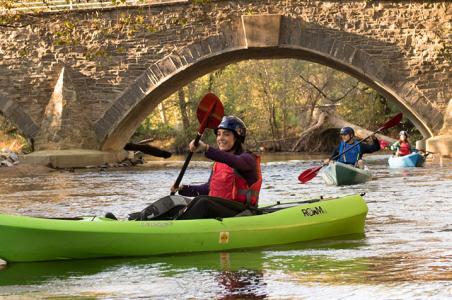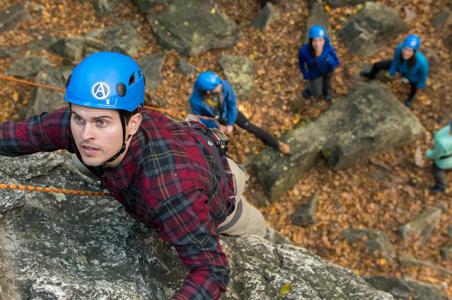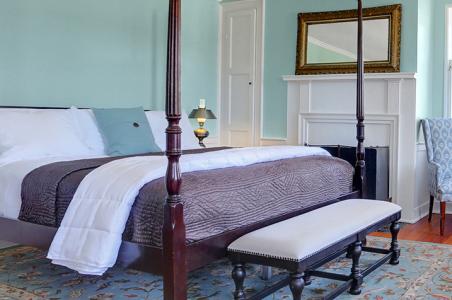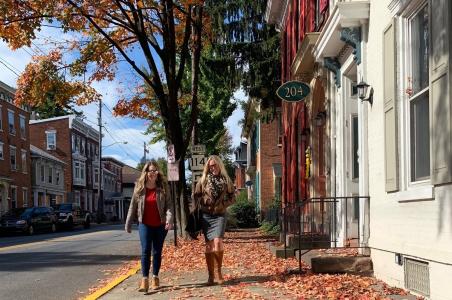The Cumberland Valley played a significant role in America’s Civil War. In the prelude to the Battle of Gettysburg, Southern troops passed through the valley, occupied communities, skirmished with the militia, and shelled towns. Through visits to historic sites, museums, and markers, visitors can explore the timeline of the Confederate invasion in the days leading up to the conflict in Gettysburg.
 Shippensburg
Shippensburg
The first major engagement in Cumberland County during the Civil War took place in Shippensburg. On June 24, 1863, a cavalry battle erupted on King Street in Shippensburg. Around 2:00 pm, as Shippensburg residents watched from their rooftops, Capt. William Boyd’s 1st New York Cavalry dashed through town with the Confederate cavalry of Brig. Gen. Albert G. Jenkins in full pursuit. By 3 pm, the rebels had gained control of Shippensburg and occupied the town until June 27. A Civil Wars Trail Marker at the intersection of King Street and Earl Street notes the occupation of Shippensburg.
Sites of interest in Shippensburg include:
- Pague & Fegan Home & Hardware (35 W. King St) – This building was known as McPherson & Cox Hardware during the time of the Civil War. As the Confederate army approached, John and Martha McPherson placed their store’s most valuable merchandise in their fireplaces and hid the openings with wallpaper. When the Confederates arrived, they never discovered the concealed items. A similar story happened at the McLean Tannery, where the quick-thinking owner concealed valuable leather hides from the Confederates.
- Dykeman Springs (1 Dykeman Rd) – Known as Indian Head Spring during the Civil War, more than 15,000 Confederate troops encamped at this spring-fed pond until leaving on June 27, marching to and capturing Carlisle. Today, the 50-acre park that surrounds Dykeman Springs features a wetlands nature trail, walking trails, and picnic facilities.
- Cumberland Valley Railroad Museum (51 E. Fort St) – In the 1860s, the CVRR ran down Earl Street and provided a link between Harrisburg and Hagerstown, MD. During the Civil War, it transported critical ammunition to the Union forces at Antietam in 1862. In June 1863, Capt. Boyd’s 1st New York Calvary detrained the CVRR in Shippensburg to delay the Confederate advance. To learn more about the history of the CVRR, stop by the Cumberland Valley Railroad Museum located in a renovated boxcar along the Cumberland Valley Rail Trail at the Shippensburg Station trailhead.
- There are also several drive-by sites with Civil War connections including the house at 20 W. King St, the boyhood home of Brig. Gen. Samuel Sturgis; 110 E. King St, which was looted by the Confederates when they learned it was the home of Union officer James Kelso; and 340 E. King St, home of Regina Agle, whose husband was killed in action in Georgia in September 1863. The Agles, the Kelsos, and the McLeans are buried in Spring Hill Cemetery. (Information provided by Pennsylvania Civil War Trails by Tom Huntington.)
Carlisle
For three days, starting on June 27, 1863, more than 10,000 Confederate troops, under the command of Lt. Gen. Richard Ewell, occupied Carlisle and the surrounding region en route to Harrisburg. While they confiscated needed supplies and damaged the Cumberland Valley Railroad, they left the town relatively unharmed.
On July 1, the first day of the Battle of Gettysburg, Carlisle was reoccupied by a Union militia commanded by Maj. Gen. William “Baldy” Smith. However, shortly after their arrival, another Confederate force approached the town and demanded its surrender. When General Smith refused, Carlisle came under several attacks resulting in minor property damage and the burning of the U.S. Army Barracks. The next morning Gen. Lee recalled his forces to the main Confederate army in Gettysburg and Carlisle was spared further damage. Sites of interest include:
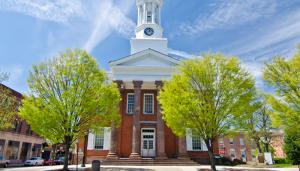 Carlisle Barracks (security checkpoint at 870 Jim Thorpe Dr) -- Home to the US Army War College, visitors are welcome to take self-guided tours of the grounds.
Carlisle Barracks (security checkpoint at 870 Jim Thorpe Dr) -- Home to the US Army War College, visitors are welcome to take self-guided tours of the grounds.- Old Cumberland County Courthouse (S. Hanover & W. High Streets) -- The courthouse still bears the marks of the artillery barrage when the Confederates shelled the town on July 1. The courthouse also heard several cases that were critical for fugitive slaves and the Underground Railroad. Visitors can view the old courtroom if it is not in use for a private event. A Civil War Trails Marker about the shelling can be found on West High Street near the Veterans Square, where a monument was dedicated in 1871 to honor the men from Cumberland County who died during the Civil War.
- Cumberland County Historical Society (21 N. Pitt St) -- 16 galleries filled with military weaponry, folk art, wood-carvings, quilts, Carlisle Indian School artifacts, and Civil War items including African American military pieces and Captain Robert C. Lamberton’s Civil War diary. The research library contains Civil War books and records. A Civil Wars Trail Marker is located by the historical society parking lot and is immediately west of 37 W. High Street.
- Army Heritage Trail (950 Soldiers Dr) -- The one-mile outdoor trail at the US Army Heritage and Education Center features interactive exhibits from the French and Indian War through the present, including recreations of Civil War winter cabins.
- Dickinson College -- The Confederates made Old West their headquarters and used East College as a hospital. A Civil War Trails Marker is located on College Street between High Street and Church Avenue.
Mechanicsburg and the West Shore
On June 28, 1863, after stops in both Shippensburg and Carlisle, Brig. Gen. Albert Jenkins marched his cavalrymen through Mechanicsburg and demanded 1,500 rations to spare the town. With no troops to offer a defense, Burgess George Hummel surrendered the town making Mechanicsburg the northernmost town to surrender to the Confederate Army.
After raiding Mechanicsburg, Gen. Jenkins briefly skirmished with the 22nd and 37th New York Militia at Sporting Hill around the Eberly farmhouse (later known as the McCormick farmhouse). This skirmish was the largest action in the Harrisburg area and the northernmost engagement of the Gettysburg campaign.
Sites of interest include:
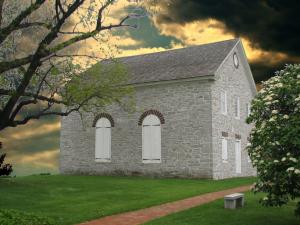 Mechanicsburg Museum (2 W. Strawberry Alley, Mechanicsburg) -- Burial lists for Mechanicsburg and Chestnut Hill Cemeteries, texts of diaries and letters written by local soldiers, discharge papers, newspapers clippings, and some personal effects including Col. H.I. Zinn’s stirrups. Their gift shop includes a book featuring transcribed letters from Daniel Cocklin of his Civil War experiences from 1862-1865.
Mechanicsburg Museum (2 W. Strawberry Alley, Mechanicsburg) -- Burial lists for Mechanicsburg and Chestnut Hill Cemeteries, texts of diaries and letters written by local soldiers, discharge papers, newspapers clippings, and some personal effects including Col. H.I. Zinn’s stirrups. Their gift shop includes a book featuring transcribed letters from Daniel Cocklin of his Civil War experiences from 1862-1865.- Historic Peace Church (corner of Trindle Rd & St. John's Church Rd, Camp Hill) – Used by the Confederates as an artillery position and outpost during June 28 and 29.
Cemeteries
 Ashland Cemetery (York Rd, Carlisle) - Created in 1865, the United States Government purchased land on the north side of the cemetery and, in September 1878, the government reinterred 500 unknown Civil War casualties, apparently from a cemetery in Maryland. This section is considered an official United States Military Cemetery.
Ashland Cemetery (York Rd, Carlisle) - Created in 1865, the United States Government purchased land on the north side of the cemetery and, in September 1878, the government reinterred 500 unknown Civil War casualties, apparently from a cemetery in Maryland. This section is considered an official United States Military Cemetery.
Chestnut Hill Cemetery (319 W. Winding Hill Rd, Mechanicsburg) was mistaken by Jenkins’ scouts for an entrenched military position. Civil War veterans and those from later wars are buried here.
Carlisle’s Old Public Graveyard (S. Bedford & E. South Streets, Carlisle) is the resting place of 750 veterans. About 550 are from the Civil War, including Charles Seebold, the drummer boy for the 1st U.S. Cavalry, who died at the age of fourteen. Also, the gravestone of William Blair (d. 1802) has a hole made by a Confederate bullet. TIP: Download the self-guided walking tour for Carlisle’s Old Public Graveyard.
Mechanicsburg Cemetery (137 W Marble St, Mechanicsburg) is the burial location for veterans from the Civil War and later wars, and a monument dedicated to Colonel Henry Zinn, who is buried in Mt. Zion Cemetery.
Locust Grove Cemetery [200 Ott Rd, Shippensburg] includes the graves of Shippensburg-area African Americans, including 26 Civil War veterans, three of whom served with the 54th and 55th Massachusetts Volunteer Regiments, among the first combat units open to black men during the Civil War. TIP: Download the self-guided walking tour of Shippensburg’s Locust Grove Cemetery.
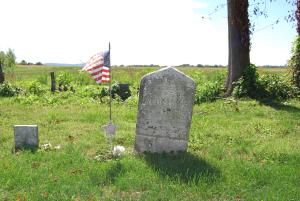 Lincoln Colored Cemetery, a.k.a. Chestnut Hill Cemetery (424 W. Winding Hill Rd, Mechanicsburg) is the resting place of 14 African American Civil War veterans. It was restored and is maintained by Vietnam Veterans of Mechanicsburg.
Lincoln Colored Cemetery, a.k.a. Chestnut Hill Cemetery (424 W. Winding Hill Rd, Mechanicsburg) is the resting place of 14 African American Civil War veterans. It was restored and is maintained by Vietnam Veterans of Mechanicsburg.
Camp Hill Cemetery (between North 21st St to the east and North 23rd St to the west with Walnut St to the south and Logan St to the north) is the final resting place of William Gorgas. At the age of 14, Gorgas witnessed the Confederates reconnaissance mission during the Battle of Oyster Point.
Mount Zion Cemetery (Route 174 & Route 74, Boiling Springs) is the final resting place of Colonel Henry Zinn. His burial spot is marked with a white obelisk.
Silver Spring Presbyterian Church [444 Silver Spring Rd, Mechanicsburg] was founded in 1734 and is the final resting for veterans from the Revolutionary War, the War of 1812, French & Indian War, the Civil War, WW I, and WW II.
Spring Hill Cemetery (114 N Morris St, Shippensburg) is the final resting place for Civil War veterans including James Kelso, who gathered men from Shippensburg to form Company D of the 130th Pennsylvania Volunteers.
St. John's Cemetery (4605 E. Trindle Rd, Mechanicsburg ) -- Founded in 1793, the cemetery adjoins historic Peace Church. Stars are stuck in the ground next to the gravestones of Union veterans.
Events
May: Army Heritage Days is a living timeline of U.S. Army history from the French and Indian War through the present. Events include military demonstrations, rifle pits, and lectures.
June: Civil War Days in the Harrisburg Area features firing demonstrations and artillery displays, lectures, and Civil War dances.
Day Trips
Cumberland Valley is an excellent hub for day trips to Harrisburg, Gettysburg, and Chambersburg.
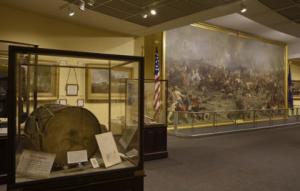 Visit the Gettysburg National Military Park Museum and Visitor Center for museum exhibits, film and cyclorama. Start your trip here to the historic battlefield that witnessed three of the bloodiest days of battle during the Civil War.
Visit the Gettysburg National Military Park Museum and Visitor Center for museum exhibits, film and cyclorama. Start your trip here to the historic battlefield that witnessed three of the bloodiest days of battle during the Civil War.
The State Museum of Pennsylvania features the narrative painting “Battle of Gettysburg: Pickett’s Charge” (1870) by Peter F. Rothermel. They also showcase artifacts that reflect the Commonwealth’s Civil War experience.
View the National Civil War Museum’s collection of more than 24,000 Civil War artifacts, manuscripts, documents, and photographs from both the Union and Confederacy for a complete and balanced account of the war.
The John Brown House in Chambersburg is where John Brown stayed while he planned his raid on the Harper’s Ferry arsenal in an attempt to arm an uprising of slaves in the fight for abolition.
Self-Guided Walking Tours
- Civil War Self-Guided Tour Shippensburg
- A Walking Tour of Shippensburg’s Locust Grove Cemetery
- Walking Tour of Carlisle’s Wayside Markers
- Carlisle’s Old Public Graveyard
- 19th-Century Historic District of Boiling Springs
- The Civil War on the West Shore Self-Guided Tour
- The Civil War Visits Carlisle: Prelude to Gettysburg
Finding the Perfect Civil War Souvenir
- Civil War & More
- History on High Shop
- Mechanicsburg Museum Store at the Freight Station
- Army Heritage and Education Center Foundation Museum Store

